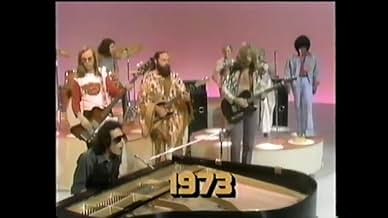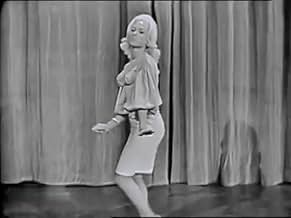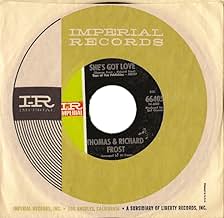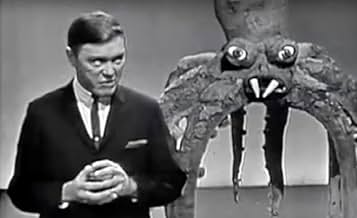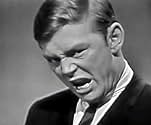Ajouter une intrigue dans votre langueDick Clark hosts a daily to weekly dance show that features the latest hit music for the attending teens to dance to. In addition, the show has performances by popular musicians and audience... Tout lireDick Clark hosts a daily to weekly dance show that features the latest hit music for the attending teens to dance to. In addition, the show has performances by popular musicians and audience members rate songs.Dick Clark hosts a daily to weekly dance show that features the latest hit music for the attending teens to dance to. In addition, the show has performances by popular musicians and audience members rate songs.
- Récompenses
- 4 victoires et 11 nominations au total
Parcourir les épisodes
Avis à la une
Although "Bandstand" apparently got its start in 1952, I first became familiar with it during the late 1950s and early 1960s, when Dick Clark was hosting the show. I became a teenager in 1958, and although I lived in a small southern town, I felt as much a part of Bandstand as those kids in Philadelphia. My mother and father both worked, so I was usually alone during the afternoon, after school. I remember my usual routine -- cook some frozen fish sticks in the oven, and settle down to watch Bandstand.
Part of the format involved playing several new songs, and having a small panel of teens rate then, to predict which ones had the best chance of becoming a hit. Of course, those of us who were watching often went over to the record store the next chance we had, to buy a copy of the winners, so the predictions became self-fulfilling. The biggest thrill was actually seeing on TV, the singers that we only knew through listening to the records. Brenda Lee. Leslie Gore. Paul and Paula. Bobby Vinton. Names that most of the younger generations would never recognize. And now, some of that is being brought to us in the Dick Clark sponsored TV series, "American Dreams." Bandstand, an important TV program in my formative teen years.
Part of the format involved playing several new songs, and having a small panel of teens rate then, to predict which ones had the best chance of becoming a hit. Of course, those of us who were watching often went over to the record store the next chance we had, to buy a copy of the winners, so the predictions became self-fulfilling. The biggest thrill was actually seeing on TV, the singers that we only knew through listening to the records. Brenda Lee. Leslie Gore. Paul and Paula. Bobby Vinton. Names that most of the younger generations would never recognize. And now, some of that is being brought to us in the Dick Clark sponsored TV series, "American Dreams." Bandstand, an important TV program in my formative teen years.
All the greatest songs ever recorded.
All the Number One Hits.
All the latest dances.
All the greatest musical guests of all time.
For three decades,Dick Clark brought you the best in entertainment.
From 1957 until 1989,this show was a Saturday afternoon staple for the teenage set.
That show was American BANDSTAND. It ran for 37 years on ABC-TV. For the three decades that it ran on the ABC network,it went on to become the third longest-running musical variety show of all time. During the last nine seasons of the show(1980-1989)the show saw a decline to some heavy competition,but due to the loyal support of the viewers,the show survived inspite to some newer viewers and a whole new generation.
It's easy to understand why it lasted three decades and was one of the top shows among the teenage set.It also paved the way for the next generation and the beginning of the "MTV" status that was to follow. Dick Clark was always the excellent and cordial host,who held his own,and remain so until the final episode of the series in 1989. Thank you,Dick Clark for making this possible.
All the Number One Hits.
All the latest dances.
All the greatest musical guests of all time.
For three decades,Dick Clark brought you the best in entertainment.
From 1957 until 1989,this show was a Saturday afternoon staple for the teenage set.
That show was American BANDSTAND. It ran for 37 years on ABC-TV. For the three decades that it ran on the ABC network,it went on to become the third longest-running musical variety show of all time. During the last nine seasons of the show(1980-1989)the show saw a decline to some heavy competition,but due to the loyal support of the viewers,the show survived inspite to some newer viewers and a whole new generation.
It's easy to understand why it lasted three decades and was one of the top shows among the teenage set.It also paved the way for the next generation and the beginning of the "MTV" status that was to follow. Dick Clark was always the excellent and cordial host,who held his own,and remain so until the final episode of the series in 1989. Thank you,Dick Clark for making this possible.
10thezone1
This was MTV before MTV. No one ever heard of Dick Clark until American Bandstand. If you were an up and coming Music Group, you fought to get on one of two shows, Ed Sullivan and American Bandstand. All the oldsters watched Ed while all the teens of the time watched American Bandstand. When I was growing up EVERYONE watched American Bandstand. Even on the small screen with tiny speakers, it was the only place you could actually see the bands you loved without going to their concerts. Then along came Soul Train. That was just a sad copy. I have no idea who hosted that show, but, EVERYONE knew who Dick Clark was. Am I right?
My family, friends and co-workers all remember Saturday's weekly TV series American Bandstand back in the 1960's and 1970's when it was THE ONLY music related theme show that could compete each week with the popularity of the following evenings Sunday night TV's Ed Sullivan show. Dick Clark as host was that perennial television star who seemed to have found the fountain of youth and just never seemed to age.
Each week the music that played and was danced to were the most popular songs of that day and when Dick Clark would ask some of the studio fans who were grooving and dancing to the music playing they would invariably respond with something like the following, "Well, I just like the beat. It's a beat we can dance to really easy. I just like the beat".
Yes for the most part the TV audience dancing to the songs playing represented a white mid-west America audience, but I believe it fair to say that American Bandstand would bring in the live talent from all across the country. The TV series sound stage was produced and filmed from the home of soul music in Philadelphia and yes from the great soul singer James Brown and Chubby Checkers, to crooners like Bobby Darin and Neil Sedaka, country singers like Johnny Cash and Dolly Parton, pop singers like the Carpenters and the Supremes, and rock and roll like Chuck Berry, the Animals and Creedence Clearwater Revival. American Bandstand never disappointed their television audience that tuned in each week to hear the beat, and maybe just a bit tongue in cheek laugh and criticize the shows dancers hokey dance moves, or their wide bell bottom pants and long hair or huge afros. Not only was American Bandstand the epicenter of the hip music, it was also a platform for teenage dress and fashion statements.
Who can not say that after more than 30 consecutive seasons on the air that if you were born prior to the 1980's that you didn't watch American Bandstand, didn't enjoy the music and the music guests that appeared each week? If you were not a fan of American Bandstand than you probably still tuned in and watched the TV show on Saturday as its critic so that you could make fun of the hokey dance moves that were displayed, the abstract fashion statements and hairdos (such as the women's beehive hairstyles and the men's two foot high afros).
Dick Clark's soothing voice and his ease with which he interacted with his musical guests made him the perfect host, and allowed us the audience to spend a Saturday for an hour or so enjoying great music guests, classic music and dance moves and ohhhh the fashion statements when we reminisce. Who can forget American Bandstand that lasted for 32 wonderful seasons. We miss you Dick Clark. God bless.
Each week the music that played and was danced to were the most popular songs of that day and when Dick Clark would ask some of the studio fans who were grooving and dancing to the music playing they would invariably respond with something like the following, "Well, I just like the beat. It's a beat we can dance to really easy. I just like the beat".
Yes for the most part the TV audience dancing to the songs playing represented a white mid-west America audience, but I believe it fair to say that American Bandstand would bring in the live talent from all across the country. The TV series sound stage was produced and filmed from the home of soul music in Philadelphia and yes from the great soul singer James Brown and Chubby Checkers, to crooners like Bobby Darin and Neil Sedaka, country singers like Johnny Cash and Dolly Parton, pop singers like the Carpenters and the Supremes, and rock and roll like Chuck Berry, the Animals and Creedence Clearwater Revival. American Bandstand never disappointed their television audience that tuned in each week to hear the beat, and maybe just a bit tongue in cheek laugh and criticize the shows dancers hokey dance moves, or their wide bell bottom pants and long hair or huge afros. Not only was American Bandstand the epicenter of the hip music, it was also a platform for teenage dress and fashion statements.
Who can not say that after more than 30 consecutive seasons on the air that if you were born prior to the 1980's that you didn't watch American Bandstand, didn't enjoy the music and the music guests that appeared each week? If you were not a fan of American Bandstand than you probably still tuned in and watched the TV show on Saturday as its critic so that you could make fun of the hokey dance moves that were displayed, the abstract fashion statements and hairdos (such as the women's beehive hairstyles and the men's two foot high afros).
Dick Clark's soothing voice and his ease with which he interacted with his musical guests made him the perfect host, and allowed us the audience to spend a Saturday for an hour or so enjoying great music guests, classic music and dance moves and ohhhh the fashion statements when we reminisce. Who can forget American Bandstand that lasted for 32 wonderful seasons. We miss you Dick Clark. God bless.
Super low budget dance party to pop hits that only lasted because it had no nationwide competition. I saw it since the early 70s. Once MTV began, it died a well deserved death.
If you liked anything but the most predictable comfortable safe bland suburban hits, you were out of luck. Soul Train had much better music and certainly better dancers. Bandstand had suburban kids who couldn't really dance. They just slightly bounced and moved their hands and never their hips.
All of it presided over by the clueless Dick Clark. Clark who never cared for pop and esp rock music by his own admission. Clark who even from the start peddled the blandest music, pushing Pat Boone instead of Little Richard.
Watch Soul Train, or Don Kirshner instead.
If you liked anything but the most predictable comfortable safe bland suburban hits, you were out of luck. Soul Train had much better music and certainly better dancers. Bandstand had suburban kids who couldn't really dance. They just slightly bounced and moved their hands and never their hips.
All of it presided over by the clueless Dick Clark. Clark who never cared for pop and esp rock music by his own admission. Clark who even from the start peddled the blandest music, pushing Pat Boone instead of Little Richard.
Watch Soul Train, or Don Kirshner instead.
Le saviez-vous
- AnecdotesWith 37 continuous years on the air, this was the longest-running weekly popular music showcase TV program in the world. The BBC's Top of the Pops (1964) broke that record in 2001, when it entered its 38th year on air.
- Versions alternativesAlso available in a computer colorized version.
- ConnexionsFeatured in The Movie Orgy (1968)
- Bandes originalesBandstand Boogie (The Theme of 'American Bandstand')
Written and Performed by Charles Albertine, Les Elgart & Bob Horn from 1952 to 1977
Meilleurs choix
Connectez-vous pour évaluer et suivre la liste de favoris afin de recevoir des recommandations personnalisées
- How many seasons does American Bandstand have?Alimenté par Alexa
Détails
- Durée
- 1h 30min(90 min)
- Rapport de forme
- 1.33 : 1
Contribuer à cette page
Suggérer une modification ou ajouter du contenu manquant



